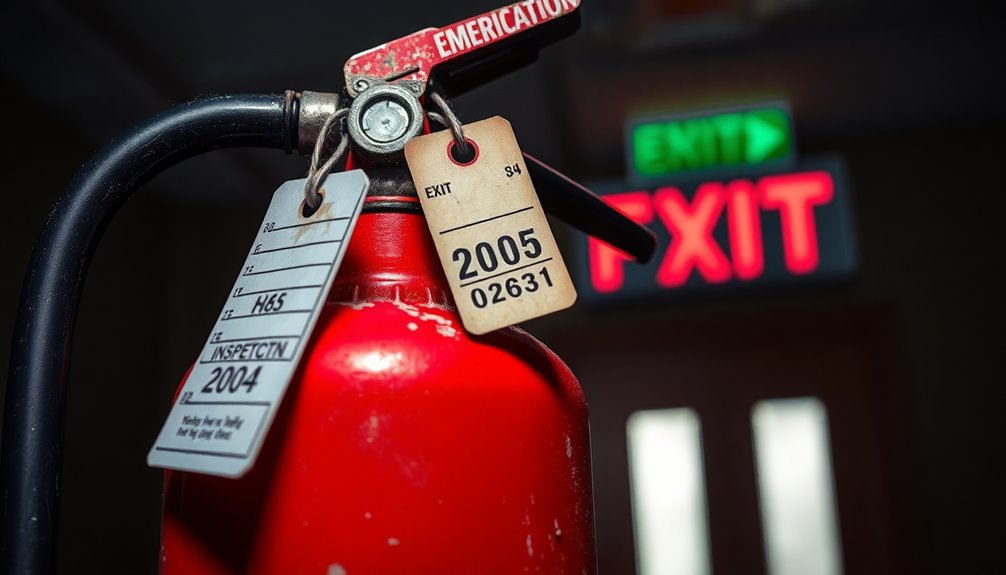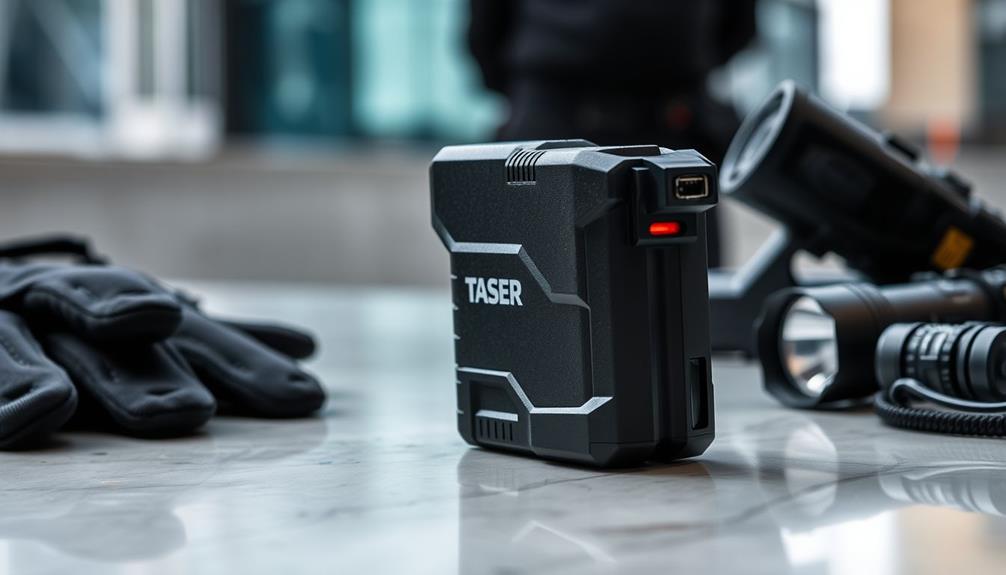When it comes to fire safety rules, one vital mistake could be deadly: using the wrong extinguisher. Each fire type requires a specific extinguisher; for example, water is effective for Class A fires, but using it on a Class B fire can worsen the situation. Regular maintenance of your fire safety equipment is essential, too. In emergencies, knowing your escape routes and practicing evacuation drills can save lives. Don't underestimate the dangers of smoke inhalation, which accounts for the majority of fire-related deaths. Stay informed about these vital aspects, as there's more important information to help you stay safe.
Key Takeaways
- Using the wrong type of fire extinguisher can worsen a fire, so always identify the fire class before responding.
- Familiarize yourself with escape routes and conduct regular fire drills to ensure quick evacuation during an emergency.
- Smoke inhalation is a major cause of fire-related deaths; stay low to the ground to avoid toxic fumes.
- Regular maintenance of fire safety equipment, like extinguishers and alarms, ensures they function properly when needed.
- Always prioritize safe evacuation over trying to extinguish a fire; never let personal safety be compromised.
Assessing Fire Size Accurately

When it comes to evaluating fire size accurately, understanding fire behavior prediction models like the FireLine Assessment Method (FLAME) is essential. This model helps you assess fire size by considering factors such as effective windspeed, fuel type, and fine-fuel moisture. By analyzing these elements, you can predict the fire rate-of-spread (ROS) more effectively.
FLAME provides a ROS-ratio, which indicates how much the ROS might change over time, giving you a clearer picture of future fire spread. Depending on the data available and the time you have, you can apply FLAME at different levels: initial, standard, or complete. This flexibility allows you to adapt your assessment based on the situation at hand.
Moreover, FLAME integrates real-time observations of current fire behavior, enabling you to extrapolate the fire's future position on the landscape. By accurately evaluating fire size and behavior, you can make informed decisions that enhance safety and improve firefighting strategies. Remember, understanding and utilizing these prediction models is a vital step in effective fire management.
Using Correct Extinguishing Techniques

Using the correct extinguishing techniques is essential for effectively managing fires and guaranteeing safety. First, identify the type of fire. For Class A fires, like those involving wood or paper, use water or foam extinguishers. If you encounter a Class B fire with flammable liquids, opt for CO2 or foam extinguishers. For electrical fires (Class C), always use non-conductive agents like CO2 to avoid electric shock. Class D fires require specialized dry powder extinguishers designed for metal fires, while Class K kitchen fires need AFFF foam combined with water mist.
When using a fire extinguisher, remember the P.A.S.S. technique: Pull the safety pin, Aim at the fire's base, Squeeze the handle, and Sweep side to side. Maintain a safe distance for quick escape if the fire worsens. Remember, water is only effective for Class A fires and can exacerbate other types.
Additionally, consider cooling techniques to remove heat, especially for Class A fires. Never use water on electrical fires or flammable liquids. Smothering techniques, like using fire blankets, can effectively cut off oxygen to small fires. Always guarantee you're using the right methods to enhance your safety and the safety of those around you.
Planning Effective Evacuation Routes

When planning effective evacuation routes, you need to designate clear exit paths that everyone can easily follow during an emergency. Regular drills are essential to guarantee everyone knows the plan and can navigate quickly. Plus, effective communication of the evacuation plans keeps everyone informed and prepared for any situation. This structured exit not only enhances worker protection but also prevents panic and confusion during emergencies.
Designate Clear Exit Paths
Designating clear exit paths is essential for guaranteeing everyone's safety during an emergency. You need to guarantee that multiple exit routes are available in every room, ideally with exits situated far apart to minimize the risk of both being blocked by fire or smoke. Make sure these routes are permanent features of your building, and keep them unobstructed at all times.
Consider these key points:
- Maintain clear routes: Keep exit paths free of flammable materials and guarantee fire exit doors are never blocked.
- Use proper signage: Install visible "EXIT" signs and guarantee they're well-lit, with no obstructions from decorations or other signs.
- Accommodate everyone: Guarantee exits meet the needs of all employees, including those with disabilities, and avoid directing people toward hazardous areas unless they're safely shielded. Additionally, consult with fire safety experts to ensure your evacuation routes comply with local fire and life safety codes.
Conduct Regular Drills
Fire drills are an essential component of any effective fire safety plan, ensuring that everyone knows how to respond in an emergency. By conducting regular drills, you'll familiarize all staff with emergency procedures and the overall Emergency Plan. This practice not only tests the effectiveness of your evacuation procedures but also helps identify weaknesses that need addressing. Consistent practice enhances preparedness and reduces panic during real emergencies.
Aim to conduct at least one drill per year, though more frequent drills—like semi-annual or quarterly—are recommended. Schedule these when the most staff are present, and even consider impromptu drills to better simulate real emergencies. Make sure to include everyone, including shift workers and part-time employees, to maximize preparedness.
Designate key roles, such as Fire Wardens and Evacuation Marshals, to oversee the evacuation and guide people to safety. It's important to record the results of each drill, as this documentation will help refine your fire safety and evacuation plans. Use observers to monitor performance during drills, and evaluate response times and coordination. By continually evaluating and improving your fire safety measures, you'll foster a 'safety-first' culture that ultimately protects everyone.
Communicate Evacuation Plans
How can you guarantee everyone knows the quickest way to safety during a fire emergency? Effective communication of your evacuation plans is essential. Start by clearly defining procedures for all situations, such as discovering a fire or hearing an alarm. Make certain everyone understands their roles, from evacuation wardens to first aid officers. Document these procedures and keep them accessible.
Next, mark escape routes clearly. You'll want to make certain exits are visible even in low-light conditions or smoke. Keep pathways clear and direct, with enough exits for everyone to leave safely. Emergency lighting can be a lifesaver in these scenarios. Additionally, ensure that emergency lighting is fully operational at all times to facilitate safe evacuation.
Lastly, develop a robust communication plan. Use multiple channels to notify everyone, like alarms and text messages. Consider these strategies:
- Designate a safe meeting point for a headcount.
- Train all employees on escape routes, including those with mobility needs.
- Regularly update training to adapt to new fire risks.
Importance of Power Shut-Off

When facing a fire emergency, locating your power supply and shutting it off can prevent additional hazards. You should prioritize safe evacuation to protect yourself and your loved ones from the dangers of fire and electrical hazards. Understanding the importance of these steps can help guarantee your safety during critical situations. Implementing a Public Safety Power Shutoff can significantly reduce the risk of fire spreading during extreme weather conditions.
Locate Power Supply First
Identifying the power supply location is essential for guaranteeing safety during emergencies, as it allows you to shut off power quickly to prevent further hazards. Knowing where the power source is not just a matter of convenience; it's critical for effective emergency response. If you can de-energize equipment swiftly, you reduce the risk of fires and electrical shocks, making it safer for everyone involved. Additionally, having a reliable backup power source is crucial to ensure that the fire alarm system remains operational during an emergency.
Here are some key reasons to locate your power supply:
- Critical for Emergency Response: Quick action can save lives and property.
- Compliance with Safety Standards: Confirm your setup meets NFPA and local electrical codes to minimize risks.
- Preventing Electrical Fires: Identifying power supplies helps spot potential hazards early and reduce electrical malfunctions.
Being proactive about power supply locations can greatly enhance your safety measures. Regular inspections and maintenance not only comply with regulations but also help in avoiding hazardous conditions. So, take the time to find and familiarize yourself with your power supply. It's a small step that could make a huge difference in an emergency.
Shut Off During Fires
Power shut-offs during fires aren't just precautionary measures; they're vital for protecting lives and property. When extreme weather conditions, like strong winds or low humidity, create high fire risks, shutting off power can prevent catastrophic outcomes. These shut-offs are based on multiple factors, including real-time observations and National Weather Service warnings. It is essential to understand that these shut-offs are a last resort after other wildfire mitigation measures have been considered.
Here's a quick overview of the power shut-off process:
| Factor | Description | Impact |
|---|---|---|
| Weather Conditions | High winds, low humidity, and hot temperatures | Increased fire risk |
| Notification Process | Alerts sent 48 and 24 hours before shut-off | Keeps the community informed |
| Duration of Shut-Off | Remains off until safety inspections are complete | Guarantees no potential hazards exist |
| Restoration Process | Inspections done by crews or drones before re-energizing | Prioritizes safety over speed |
| Community Preparation | Recommendations for emergency kits and contact updates | Helps residents stay ready
Prioritize Safe Evacuation
During a fire emergency, prioritizing safe evacuation can mean the difference between life and death. You should evacuate the building immediately when the fire alarm sounds or when instructed by emergency personnel. Remember to inform those around you to evacuate and use the stairs instead of elevators. Closing doors behind you can help slow the spread of fire and smoke.
To guarantee a smooth evacuation, keep these key points in mind:
- Know your escape routes: Familiarize yourself with all exit routes and guarantee they're marked clearly.
- Help others: Assist those who may need help, but don't put yourself in danger.
- Stay organized: Go to the designated assembly point and perform a headcount to guarantee everyone is accounted for.
Additionally, remember that when the alarm sounds, activate the fire alarm to ensure everyone is aware of the situation. Always remain calm and encourage others to do the same. If the smoke gets thick, stay low to the ground. Communicate effectively with emergency personnel about anyone who may need assistance. Prioritizing safe evacuation not only protects you but also helps safeguard lives around you.
Understanding Extinguisher Types

When it comes to fire safety, understanding extinguisher types is vital for effectively tackling different fire classes. Each class of fire requires a specific type of extinguisher to guarantee safety and effectiveness. For instance, Class A fires, involving ordinary combustibles like wood and paper, can be tackled with Water or Foam extinguishers, identifiable by their white and cream color zones, respectively. It is crucial to ensure that your extinguishers comply with BS EN3 standards to maintain safety and effectiveness in emergencies.
For flammable liquids (Class B), use Foam, Dry Powder, or Carbon Dioxide (CO2) extinguishers. CO2 extinguishers, marked by a black zone, are particularly useful for electrical fires, as they're non-conductive.
When dealing with cooking oil fires (Class F), Wet Chemical extinguishers can create a barrier to prevent re-ignition. If you encounter combustible metals (Class D), specialized Dry Powder extinguishers are necessary.
It's important to remember that using the wrong extinguisher can exacerbate the situation. Always check the color coding and verify you're using the correct type for the fire at hand. This knowledge not only helps you act swiftly in emergencies but can also save lives.
Common Fire Safety Mistakes

Understanding the types of fire extinguishers is just one part of fire safety; being aware of common fire safety mistakes can make a significant difference in preventing disasters. You might not realize how easily a small oversight can lead to a fire. Here are some common mistakes to avoid:
- Daisy-chaining extension cords: This can cause overheating. Always plug directly into a wall socket.
- Overloading circuits: Plugging too many devices into one outlet increases fire risk. Be mindful of your electrical load.
- Ignoring maintenance: Neglecting to clean dryer filters and chimneys can lead to dangerous lint buildup and flammable debris. Regularly checking indoor air quality can also help prevent conditions that might lead to fire hazards.
In addition to these, improper storage of combustibles and failing to maintain clear escape routes can turn a minor issue into a major disaster. Improper organization of storage areas can also increase fire risk, leading to potentially deadly situations. Make certain you have a solid fire safety plan in place, including regular checks of alarms and extinguishers. Remember, quick and informed actions can save lives when it comes to fire safety. Stay vigilant, and make these small changes to guarantee you’re not making deadly mistakes. Also, it’s important to train your staff or household members on proper fire safety procedures and the use of fire extinguishers. Additionally, consider implementing a failproof fire starting method, such as using only approved ignition sources and teaching proper fire-building techniques. It’s crucial to be proactive and prepared when it comes to fire safety, as even a small oversight can have devastating consequences.
Recognizing Fire Spread Risks

To protect against fire spread, you need to assess the growth potential of any fire that could ignite. Start by identifying hazardous materials around you, as these can greatly increase the risk of rapid fire escalation. Understanding these factors is essential for maintaining a safe environment and preventing disasters. Conducting a fire risk assessment will help you systematically evaluate your surroundings to identify potential hazards and implement necessary safety measures.
Assessing Fire Growth Potential
Fire growth potential plays a crucial role in recognizing fire spread risks, especially in environments susceptible to both accidental and arson-related fires. Understanding the differences in fire growth rates can help you evaluate the danger accurately. For instance, arson fires can have a fire growth rate that's 110% higher at the 99.5th percentile compared to accidental fires. This significant difference underscores the importance of thorough fire risk evaluations.
When evaluating fire growth potential, consider these key factors:
- Fire Growth Rates: Analyze fire growth rates specific to your environment, noting that arson fires may have higher rates.
- Modeling Techniques: Employ fire risk assessment models like HAZARD I to simulate potential fire scenarios based on historical data, while recognizing that micro-scale fire growth capacity (FGC) is essential for predicting fire performance.
- Building Design: Confirm that building designs account for the possibility of arson, especially in high-risk areas, to enhance safety measures.
Identifying Hazardous Materials
Recognizing hazardous materials is essential for preventing fire spread and guaranteeing safety in any environment. The United Nations classifies dangerous goods into nine categories, with Classes 1 through 4 being particularly important. Class 1 includes explosives like dynamite, while Class 2 covers compressed gases, both flammable and toxic. Flammable liquids, such as gasoline, fall under Class 3, and Class 4 consists of flammable solids like sulfur and flour dust.
You should always confirm that chemicals and fuels are clearly labeled, utilizing U.S. Department of Transportation placards and NFPA 704 markings. For certain quantities, display signage outside the workplace to alert others to potential hazards. Store incompatible materials separately in well-ventilated areas, using bund walls for spill containment. Additionally, implementing active fire prevention methods like oxygen reduction can significantly enhance safety in the storage of hazardous materials.
It's critical to adhere to regulatory guidelines, such as TRbF and TRGF for flammable liquids, and NFPA standards for lab storage. By following these practices, you can greatly reduce the risk of fire spread and enhance safety in your environment. Make it a point to stay informed and vigilant regarding hazardous materials.
Practicing Regular Evacuation Drills

It's essential for everyone in a building to practice regular evacuation drills. These drills guarantee that you, your colleagues, and visitors know escape routes, emergency exits, and safety protocols. By making evacuation procedures second nature, you can greatly reduce panic and confusion during an actual emergency.
Key benefits of practicing regular evacuation drills include:
- Familiarity: You'll know exactly what to do and where to go when the alarm rings.
- Time Efficiency: Regular practice helps set evacuation time targets, minimizing delays that could lead to injuries or fatalities.
- Continuous Improvement: Drills allow you to identify and correct flaws in the evacuation process, enhancing overall safety. Regular drills also verify the operational status of fire alarms and emergency lighting, ensuring preparedness through consistent maintenance checks.
In addition, training new staff on fire evacuation procedures guarantees that everyone is prepared. Assigning roles like fire wardens streamlines the process and makes it more efficient. Remember, conducting at least one fire drill per year is a legal requirement. However, multiple drills per year are recommended to strengthen safety measures. Regular debriefing sessions after drills help discuss findings and implement necessary changes, guaranteeing your entire building is ready for any emergency.
Maintenance of Fire Safety Equipment

Regular maintenance of fire safety equipment is vital for guaranteeing a safe environment. Compliance with regulations, like those set by the National Fire Protection Association (NFPA) and Australian Standards AS1851 and AS2444, is significant. Regular inspections not only help you avoid legal consequences but also ascertain that your equipment adheres to fire safety codes.
By regularly checking your fire safety equipment, you can detect faults and defects early. This includes checking for leaks or rust in fire hoses and verifying that fire pumps and sprinkler systems function correctly. Visual inspections by fire wardens between professional checks can help spot minor issues before they become major problems. Additionally, regular maintenance can help identify potential issues, allowing for timely repairs that reduce the risk of malfunction during emergencies.
Regular maintenance also certifies that your fire fighting equipment remains functional. Smoke alarms and emergency lighting need to be operational and tested often. Fire extinguishers require monthly checks and annual servicing by licensed inspectors.
Awareness of Smoke Inhalation Dangers

During a fire, smoke inhalation poses a significant threat to your health and safety. It's essential to recognize the dangers associated with smoke, which not only consumes oxygen but also contains harmful chemicals like carbon monoxide and hydrogen cyanide. These substances can severely impair your body's ability to use oxygen, leading to life-threatening conditions.
Here are some key points to keep in mind:
- Immediate Symptoms: You might experience coughing, wheezing, or shortness of breath, and confusion or dizziness can set in quickly.
- Long-term Effects: Prolonged exposure can lead to chronic respiratory conditions, including asthma or even lung cancer. In fact, smoke inhalation accounts for 50%-80% of fire-related deaths, surpassing burns.
- Emergency Response: Always seek medical attention, even if symptoms seem mild. Smoke inhalation can escalate rapidly.
Understanding these risks can mean the difference between life and death. Verify smoke detectors are functional and have an escape plan in place. Remember, in emergencies, every second counts, and being prepared can save your life. Stay aware and prioritize your safety to mitigate the dangers of smoke inhalation.
Frequently Asked Questions
How Can I Prevent Fires From Starting in the First Place?
To prevent fires from starting, you should keep flammable materials away from heat sources and maintain a clutter-free environment. Use electrical appliances safely by avoiding overloaded outlets and unplugging unused devices. Regularly check your smoke alarms and replace batteries as needed. In the kitchen, never leave cooking unattended, and create a kid-free zone around the stove. Finally, follow outdoor fire regulations to guarantee safety in your backyard or during camping trips.
What Should I Do if My Smoke Alarm Goes Off?
If your smoke alarm goes off, don't ignore it. Assume there's a fire and immediately alert everyone in your household. Follow your escape plan without trying to fight the fire. Check doors for heat before opening, and use an alternate exit if necessary. Once outside, meet at your designated spot and call the fire department, providing them with your details. Stay clear of the building and wait for responders to arrive.
Are There Specific Fire Safety Tips for Children?
When teaching fire safety to children, focus on understanding, practicing, and responding. Explain the purpose of smoke alarms, teach them the sound, and show them what to do when they hear it. Create an evacuation plan together, practice crawling low, and checking doors for heat. Reinforce the importance of not going back inside during a fire and using "Stop, Drop and Roll" if clothes catch fire. Empower them with knowledge for safety!
How Often Should I Replace My Smoke Alarms?
You should replace your smoke alarms every 10 years or when the "replace by" date is reached. This timeframe applies to both hard-wired and battery-powered alarms, as the sensors degrade over time. If you notice yellow discoloration, repeated chirping, or it doesn't sound during tests, it's time for a replacement. Regularly check your smoke alarms, test them monthly, and keep them clean to guarantee they function properly when needed.
What Materials Should I Avoid Storing Near Heat Sources?
Imagine a spark igniting a hidden danger, spreading before you even realize it. To prevent this, don't store combustible materials like wood, paper, or cardboard near heat sources. Flammable liquids and gases also need to stay far away from flames or heat. Always keep these materials in designated areas, ensuring they're safely distanced from potential ignition sources. Your vigilance today could make all the difference tomorrow in keeping your space safe.
Conclusion
In fire safety, knowing the risks, understanding the tools, and planning your actions can save lives. You need to assess fire size, use the right extinguishing techniques, and recognize how fires spread. You must also practice evacuation drills, maintain your equipment, and be aware of smoke inhalation dangers. By taking these steps seriously, you're not just protecting yourself; you're ensuring the safety of everyone around you. Stay alert, stay prepared, and stay safe.










